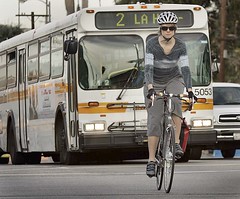Selling coals to Newcastle, is that like pushing bicycling in Los Angeles?
 Monica Howe shares the road with heavyweights during a trip into downtown L.A. “To ride a bike in L.A. is to examine the accepted ways of doing things,” she says. “It’s a way of stepping out and seeing things in a different way.” (Al Seib / LAT)
Monica Howe shares the road with heavyweights during a trip into downtown L.A. “To ride a bike in L.A. is to examine the accepted ways of doing things,” she says. “It’s a way of stepping out and seeing things in a different way.” (Al Seib / LAT)See "She's L.A.'s pedal pusher" from the LA Times. From the article:
"In Los Angeles, people are sick of driving, sick of looking for parking. And most trips are under five miles. But people don't want to ride in a city that feels dangerous."
She has thrown herself into the campaign to demand the stenciling of "sharrows" on city streets. A sharrow is a bicycle symbol with two chevrons that is meant to remind motorists to share the road and also to promote better lane positioning for those on bikes. Howe has rallied cyclists to demand safer streets. She has led efforts to support cyclists hit by cars. She has promoted group rides that bring residents in touch with unfamiliar neighborhoods. She hammers away on the idea that bicycles are the only zero-emission transit machines."
It's a Catch-22," Howe said. "Officials in this city won't take the moves to make it safe until there are more bicyclists. Until they see bicycles all over the road, they will continue to regard us as freaks. Yet, those who commute by bicycle today are taking huge risks.
--------------
The point about needing a critical mass of bicyclers reminds me somehow of this point about how do we link interest in the home (the nesting or cocooning phenomenon) to positive attitudes about historic preservation?
Index Keywords: bicycling



0 Comments:
Post a Comment
<< Home